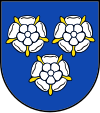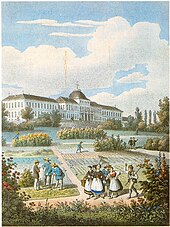Plieningen
|
Plieningen City district of the state capital Stuttgart |
|||||||||||||||||||||||||||||||
|---|---|---|---|---|---|---|---|---|---|---|---|---|---|---|---|---|---|---|---|---|---|---|---|---|---|---|---|---|---|---|---|
| District coat of arms | City map | ||||||||||||||||||||||||||||||

|
|||||||||||||||||||||||||||||||
| List of districts of Stuttgart | |||||||||||||||||||||||||||||||
| Incorporation : | April 1, 1942 | ||||||||||||||||||||||||||||||
| Height : | 370 m above sea level NHN | ||||||||||||||||||||||||||||||
| Population density : | 1,025 inhabitants per km² | ||||||||||||||||||||||||||||||
| Postal code : | 70599 | ||||||||||||||||||||||||||||||
| Area code : | 0711 | ||||||||||||||||||||||||||||||
| Address of the district town hall: |
Filderhauptstrasse 155 70599 Stuttgart |
||||||||||||||||||||||||||||||
| Website: | www.stuttgart.de | ||||||||||||||||||||||||||||||
| District Head: | Andrea Lindel | ||||||||||||||||||||||||||||||
|
|||||||||||||||||||||||||||||||
| Transport links | |||||||||||||||||||||||||||||||
| Highway |
|
||||||||||||||||||||||||||||||
| Federal road |
|
||||||||||||||||||||||||||||||
| Light rail | U 3 | ||||||||||||||||||||||||||||||
| bus | 65, 70, 73, 74, 76, 122 | ||||||||||||||||||||||||||||||
| Source: Stuttgart data compass | |||||||||||||||||||||||||||||||
Coordinates: 48 ° 42 ' N , 9 ° 13' E
Plieningen is the southernmost district of Stuttgart , around ten kilometers from the city center on the Filder plain . The Hohenheim Castle , part of the Stuttgart airport and the parking garage of the Messe Stuttgart are at Plieninger district.
history
A Roman Jupiter column (280 AD) on the Körsch as well as an estate and some finds remind of the Roman settlement. The old Heerstraße (Echterdinger Straße) and Paracelsusstraße are old Roman roads.
Around 500 the settlement took place through the Pleonungen . The early church of St. Martinus was built around 600 as a wooden structure. It was one of the first churches in the Filder region. In the 12th century, Hugo von Plieningen took part in a crusade to Jerusalem, and the three roses on the rose branch contained in the coat of arms are said to be due to this. Since the 12th and 13th centuries, the lords of Plieningen u. a. in Plieningen (Plieningen Castle ), Esslingen , Göppingen and Kleinbottwar. The oldest commercial enterprise in Plieningen is the Obere Seemühle from the 12th century in the Körschtal.
In 1747 the old town hall was built in Mönchhof. In 1770, Carl Eugen von Württemberg had the new Hohenheim Palace built on top of the moated castle. As a result, the neighboring community of Birkach emerged as a street village with the Franziska Church .
|
Plieningen and Birkach were forcibly incorporated into Stuttgart on April 1, 1942 and then run as districts.
When the city of Stuttgart was divided into districts in 1956, the district of Plieningen was initially divided into the three districts of Plieningen, Hohenheim and Steckfeld. This is administered in personal union with the district of Birkach, which initially consisted of the districts of Birkach and Schönberg, and also has a joint district town hall in Plieningen (Garbe). From 1968 to 1972 the new Asemwald district was created in Plieningen , so that the Plieningen district had four districts. The Chausseefeld residential area, which was built at the end of the 1990s, was officially designated as a separate district of Plieningen when the Stuttgart districts were reorganized on January 1, 2001, so that since then the Plieningen district has been divided into the five districts of Plieningen, Asemwald, Chausseefeld, Hohenheim and Steckfeld. |
traffic
Plieningen is directly connected to the A 8 (Karlsruhe – Munich), the B 27 (Stuttgart – Tübingen), the airport and the exhibition center via two state roads .
Local public transport by rail is served by the U3 light rail line from Plieningen via Möhringen to Vaihingen . Today it runs on the former Stuttgart-Möhringen-Stuttgart-Hohenheim railway line which was opened by the Filderbahn company in 1888 and which has been taken over by the Stuttgart trams (SSB) over the years . However, the tram only stops on the outskirts of Plieningen, and several regional bus routes serve as feeders. The SSB bus routes 65 (Plieningen– Obertürkheim ), 70 (Plieningen– Hoffeld ), 73 ( Degerloch - Neuhausen ), 74 (Degerloch– Nürtingen ) and 76 (Degerloch– Echterdingen ) as well as the bus route 122 of the END Verkehrsgesellschaft ( Airport - Esslingen ).
Sports
- The gymnastics club Plieningen 1873 , founded in 1873, has around 1,300 members, around 900 of them in the gymnastics department.
Culture and sights
- Hohenheim Palace with zoological and veterinary museum
- University of Hohenheim with the state arboretum (exotic garden), botanical garden, German agricultural museum and museum of the history of Hohenheim
- Heimatmuseum Plieningen - until 2009 in the old town hall, since May 2015 in the tithe barn.
- Evang. Martinskirche Plieningen , monument and early church (stone building from the 12th century). Is considered the landmark of Plieningen.
- "Stone Cross" (Neuhauser Strasse) and "Bildstockstein" (Echterdinger Strasse)
- Mönchhof (historical center)
- Körschtal with the upper and lower mills and the mill lake
politics
|
Local election 2014
% 30th 20th 10
0
29.7
23.7
15.5
7.9
6.5
6.5
3.3
2.9
4.0
Gains and losses
Due to the number of inhabitants in the district, the Plieningen District Advisory Board has 12 full and just as many deputy members. The following distribution of seats has been in effect since the last local elections in 2014:
|
Personalities
- Helisäus Röslin (1545–1616), physician, astrologer, chronologist and geographer
- Johann Georg Hartmann (1731–1811), Württemberg court and domain councilor
- Christian Gottlieb Göz (1746–1803), pastor in Plieningen and Hohenheim
- Winfried Kretschmann , lived in Plieningen during his studies
Literature / homeland books
- Oerny B. Lunke: Röslesland 1: "The story then and now" - Plieningen, Hohenheim, Birkach. Illustrated with GPS location information: Plieningen, Hohenheim, Birkach, Ridenberg. Description of place from church registers and descriptions of Oberamts Pf. Mezger 1903 . 1st edition. Stuttgart: Atelier Lunke TY Culture, 2013, ISBN 978-3-931074-14-2 .
- Oerny B. Lunke: Röslesland 2: "Historical local views 1" - Photo Plieningen, Hohenheim, Birkach. Illustrated with GPS location information: historical recordings . 1st edition. Stuttgart: Atelier Lunke TY Culture, 2013, ISBN 978-3-931074-15-9 .
- Oerny B. Lunke: Röslesland 3 : Photo book "Historisch Mobil" - Plieningen, Hohenheim, Birkach. Cars, coaches, motorcycles, bicycles, some with GPS location information: Plieningen, Hohenheim, Birkach, Riedenberg, historic vehicles . 1st edition. Stuttgart: TY Culture, 2014, ISBN 978-3-931074-16-6 .
- Oerny B. Lunke: Röslesland 4 : Photo book "Home and Families 1" - Plieningen, Hohenheim, Birkach. Historically old family records from 1850–1930 as well as family trees . 1st edition. Stuttgart: Atelier Lunke TY Culture, 2014, ISBN 978-3-931074-17-3 .
- Oerny B. Lunke: Röslesland 5 : Photo book "aerial photography Röslesland" - Plieningen, Hohenheim, Birkach. Historical recordings compared to today, with double-sided panoramic aerial photos, 70 photos and graphics, the oldest from 1918 . 1st edition. Stuttgart: Atelier Lunke TY Culture, 2014, ISBN 978-3-931074-18-0 .
- Reinhard Breymayer : The author of a model for Schiller's "Taucher", finally found: Christian Gottlieb Göz (1746–1803), pastor in Plieningen and Hohenheim, friend of Philipp Matthäus Hahn ? In: Leaves for Württemberg Church History 83/84 (1983/1984) . Stuttgart 1985, p. 54-96 .
Web links
- 70599-bw.de - Private website about Plieningen and Birkach
- Heimatmuseum Plieningen on the website of the Stuttgart City Museum
Individual evidence
- ^ Children and Health in Focus , Stuttgarter Nachrichten , article from April 7, 2012, accessed September 9, 2012.
- ↑ stadtmuseum-stuttgart.de
- ↑ http://www.stuttgarter-zeitung.de/inhalt.wo-alles-begann-winfried-kretschmann-rote-fahne-und-mikoskop.22f5405b-092e-4751-b014-b9264a6925ca.html









